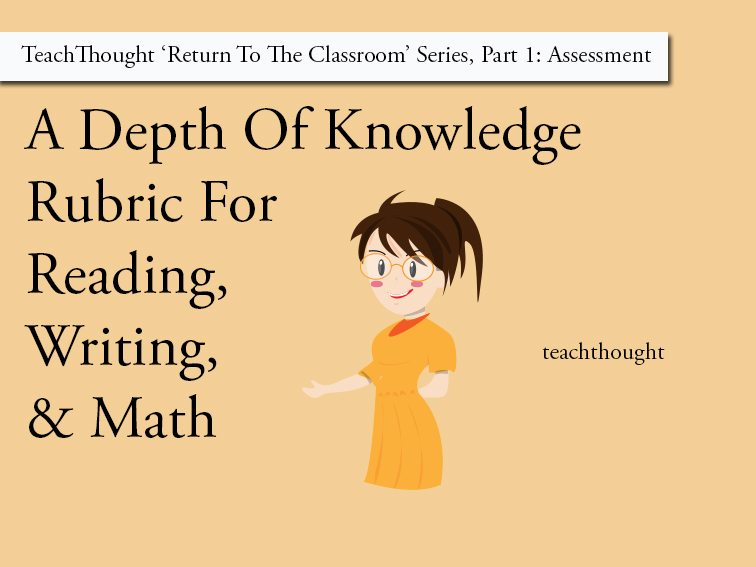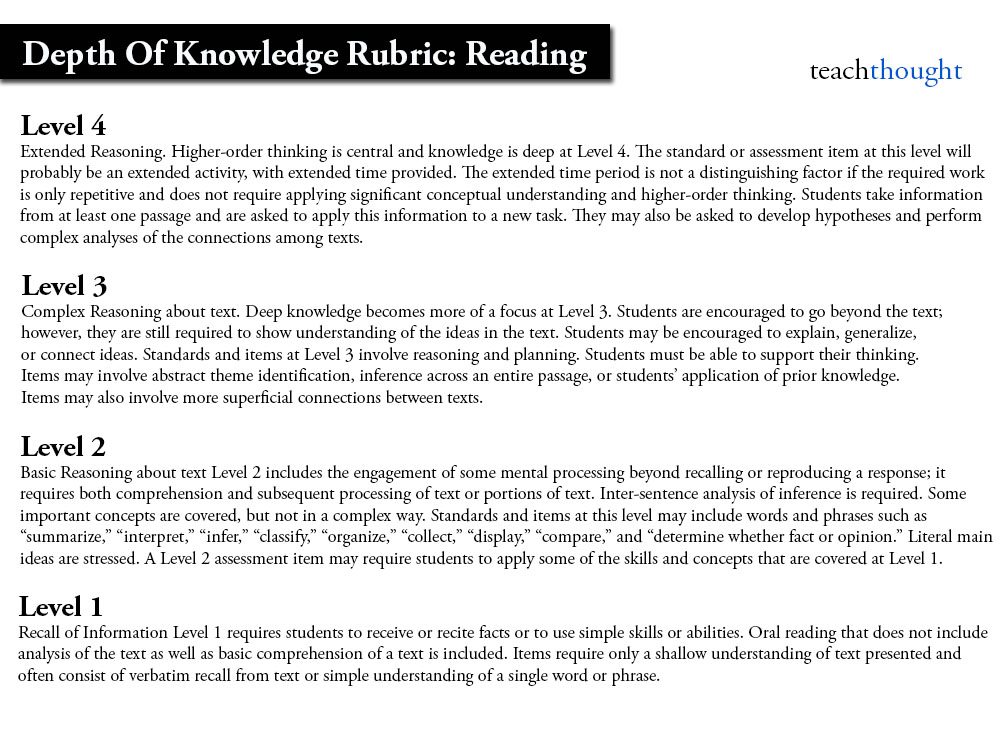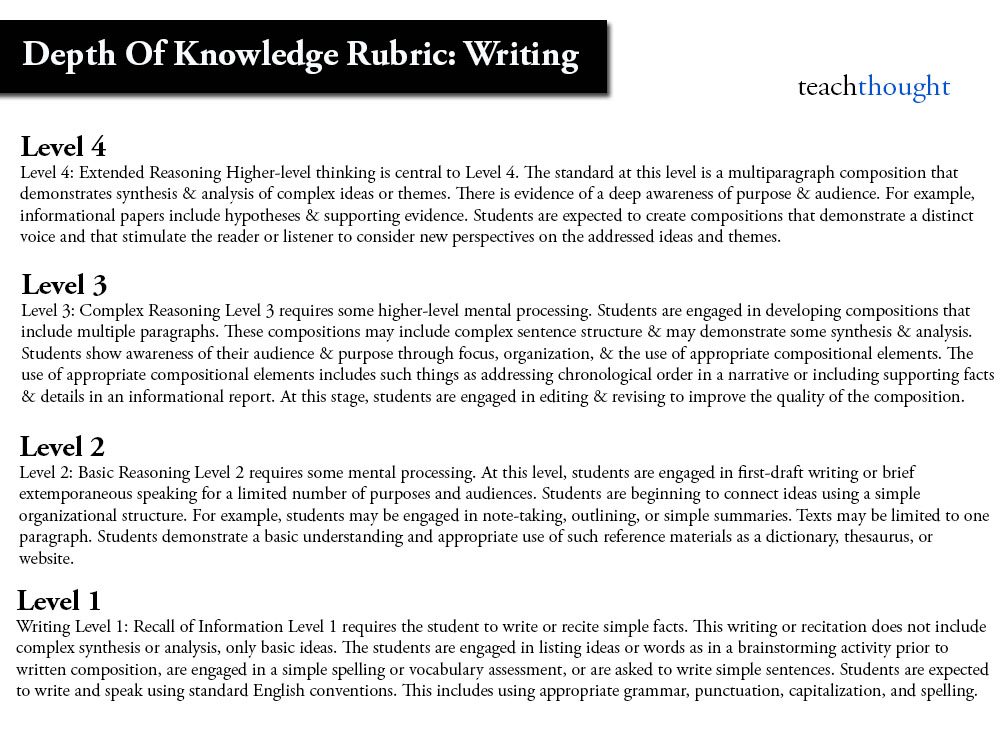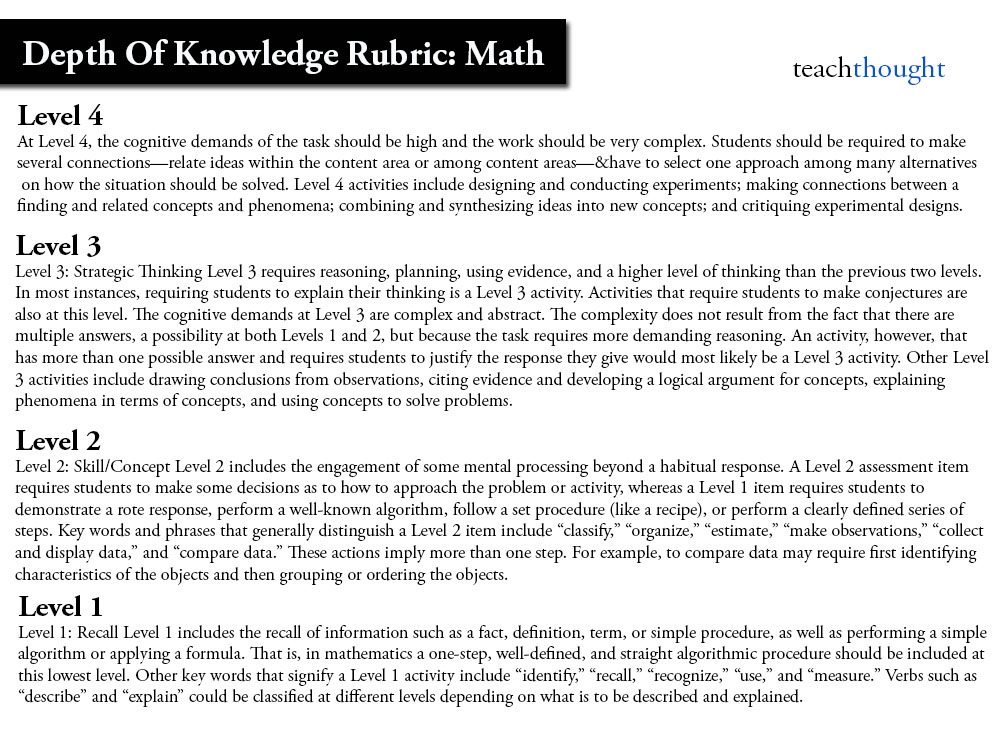
A DOK Rubric For Reading, Writing, And Math
by Terry Heick
My first three years as a teacher, my district used Norman Webb’s Depth of Knowledge framework.
Bloom’s Taxonomy gets most of the press in education, and UbD 6 Facets of Understanding, and Marzano’s New Taxonomy are also useful frameworks for dispersing ‘cognitive actions,’ but it was the ‘DOK’ model that I used first, and so it has a soft spot in my heart. I found the numbers more useful–as a new teacher–than the abstractions of already complex language. Making sense of a taxonomy requires a teacher to understand the structure and language of the thing, internalize it, contextualize it within a classroom, and then further understand how to use it as a teaching tool.
Taxonomies can be used to create assessment, map big ideas in a curriculum, structure discussions–in fact, this should probably be a post of its own. But back to Webb & DOK–Grant Wiggins recently shared a post on assessment design–or rather, the reality of ‘power verbs’ as they relate to rigor (always a fun word) and complexity. He shared the DOK rubric in text form, and I thought it might be useful to create a graphic for each one individually for easier sharing and curation.
The basic organization here is higher numbers = higher levels of thinking. In the same way educators value student thinking in the highest levels of Bloom’s, thinking–and requisite work–designed at DOK levels 3 and 4 represent said ‘higher-level thinking.’
As with all things in education, thinking is a matter of trend. DOK is seemingly trending down, while Bloom’s is always in fashion. Whether or not you use it as an instructional design and teaching tool or not, the language in the descriptions below might be useful to you–if for no other reason, than to see what makes certain tasks in certain content areas increasingly complex.

A Depth of Knowledge Rubric for Reading
Level 1: Recall of Information
Level 1 requires students to receive or recite facts or to use simple skills or abilities. Oral reading that does not include analysis of the text as well as basic comprehension of a text is included. Items require only a shallow understanding of text presented and often consist of verbatim recall from text or simple understanding of a single word or phrase.
Level 2: Basic Reasoning about text
Level 2 includes the engagement of some mental processing beyond recalling or reproducing a response; it requires both comprehension and subsequent processing of text or portions of text. Inter-sentence analysis of inference is required. Some important concepts are covered, but not in a complex way. Standards and items at this level may include words and phrases such as summarize, interpret, infer, ‘classify,’ ‘organize,’ ‘collect,’ ‘display,’ ‘compare,’ and ‘determine whether fact or opinion.” Literal main ideas are stressed. A Level 2 assessment item may require students to apply some of the skills and concepts that are covered at Level 1.
Level 3: Complex Reasoning about text
Depth of knowledge becomes more of a focus at Level 3. Students are encouraged to go beyond the text; however, they are still required to show understanding of the ideas in the text. Students may be encouraged to explain, generalize, or connect ideas. Standards and items at Level 3 involve reasoning and planning. Students must be able to support their thinking. Items may involve abstract theme identification, inference across an entire passage, or students’ application of prior knowledge. Items may also involve more superficial connections between texts.
Level 4: Extended Reasoning
Higher-order thinking is central and knowledge is deep at Level 4. The standard or assessment item at this level will probably be an extended activity, with extended time provided. The extended time period is not a distinguishing factor if the required work is only repetitive and does not require applying significant conceptual understanding and higher-order thinking. Students take information from at least one passage and are asked to apply this information to a new task. They may also be asked to develop hypotheses and perform complex analyses of the connections among texts.

A Depth of Knowledge Rubric for Writing
Writing Level 1: Recall of Information
Level 1 requires the student to write or recite simple facts. This writing or recitation does not include complex synthesis or analysis, only basic ideas. The students are engaged in listing ideas or words as in a brainstorming activity prior to written composition, are engaged in a simple spelling or vocabulary assessment, or are asked to write simple sentences. Students are expected to write and speak using standard English conventions. This includes using appropriate grammar, punctuation, capitalization, and spelling.
Level 2: Basic Reasoning
Level 2 requires some mental processing. At this level, students are engaged in first-draft writing or brief extemporaneous speaking for a limited number of purposes and audiences. Students are beginning to connect ideas using a simple organizational structure. For example, students may be engaged in note-taking, outlining, or simple summaries. Texts may be limited to one paragraph. Students demonstrate a basic understanding and appropriate use of such reference materials as a dictionary, thesaurus, or website.
Level 3: Complex Reasoning
Level 3 requires some higher-level mental processing. Students are engaged in developing compositions that include multiple paragraphs. These compositions may include complex sentence structure and may demonstrate some synthesis and analysis. Students show awareness of their audience and purpose through focus, organization, and the use of appropriate compositional elements.
The use of appropriate compositional elements includes such things as addressing chronological order in a narrative or including supporting facts and details in an informational report. At this stage, students are engaged in editing and revising to improve the quality of the composition.
Level 4: Extended Reasoning
Higher-level thinking is central to Level 4. The standard at this level is a multi-paragraph composition that demonstrates synthesis and analysis of complex ideas or themes. There is evidence of a deep awareness of purpose and audience. For example, informational papers include hypotheses and supporting evidence. Students are expected to create compositions that demonstrate a distinct voice and that stimulate the reader or listener to consider new perspectives on the addressed ideas and themes.

A Depth of Knowledge Rubric for Mathematics
Level 1: Recall
Level 1 includes the recall of information such as a fact, definition, term, or simple procedure, as well as performing a simple algorithm or applying a formula. That is, in mathematics a one-step, well-defined, and straight algorithmic procedure should be included at this lowest level. Other key words that signify a Level 1 activity include “identify,” “recall,” “recognize,” “use,” and “measure.” Verbs such as “describe” and “explain” could be classified at different levels depending on what is to be described and explained.
Level 2: Skill/Concept
Level 2 includes the engagement of some mental processing beyond a habitual response. A Level 2 assessment item requires students to make some decisions as to how to approach the problem or activity, whereas a Level 1 item requires students to demonstrate a rote response, perform a well-known algorithm, follow a set procedure (like a recipe), or perform a clearly defined series of steps. Key words and phrases that generally distinguish a Level 2 item include “classify,” “organize,” “estimate,” “make observations,” “collect and display data,” and “compare data.” These actions imply more than one step. For example, to compare data may require first identifying characteristics of the objects and then grouping or ordering the objects.
Level 3: Strategic Thinking
Level 3 requires reasoning, planning, using evidence, and a higher level of thinking than the previous two levels. In most instances, requiring students to explain their thinking is a Level 3 activity. Activities that require students to make conjectures are also at this level. The cognitive demands at Level 3 are complex and abstract. The complexity does not result from the fact that there are multiple answers, a possibility at both Levels 1 and 2, but because the task requires more demanding reasoning. An activity, however, that has more than one possible answer and requires students to justify the response they give would most likely be a Level 3 activity.Other Level 3 activities include drawing conclusions from observations, citing evidence and developing a logical argument for concepts, explaining phenomena in terms of concepts, and using concepts to solve problems.
Level 4: Extended Thinking
Level 4 requires complex reasoning, planning, developing, and thinking—most likely over an extended period of time. The extended time period is not a distinguishing factor if the required work is only repetitive and does not require applying significant conceptual understanding and higher-order thinking. For example, if a student has to take the water temperature from a river each day for a month and then construct a graph, this would be classified as a Level 2 activity. However, if the student is to conduct a river study that requires taking into consideration a number of variables, this would be a Level 4 activity.
At Level 4, the cognitive demands of the task should be high and the work should be very complex. Students should be required to make several connections—relate ideas within the content area or among content areas—and have to select one approach among many alternatives on how the situation should be solved. Level 4 activities include designing and conducting experiments; making connections between a finding and related concepts and phenomena; combining and synthesizing ideas into new concepts; and critiquing experimental designs.
A Depth Of Knowledge Rubric For Reading, Writing, And Math
